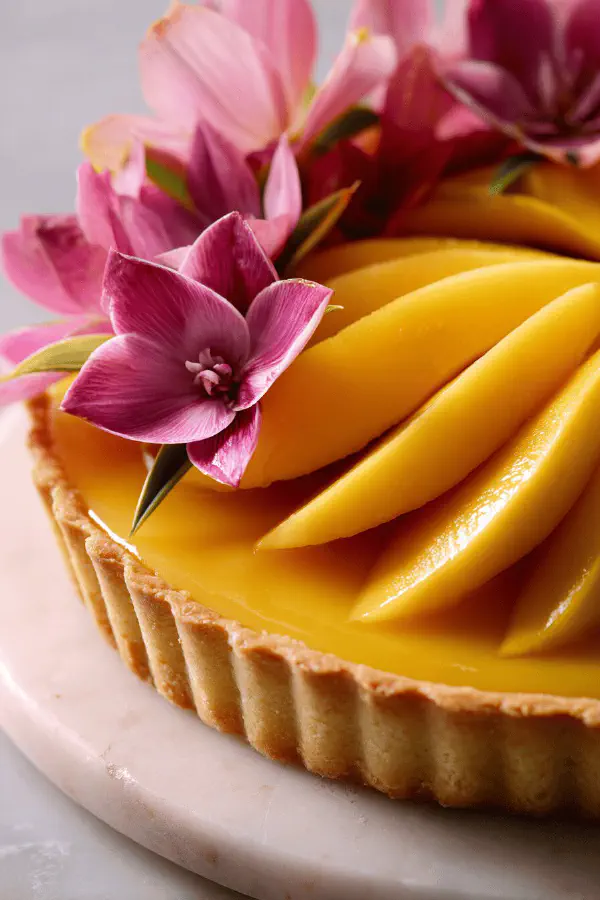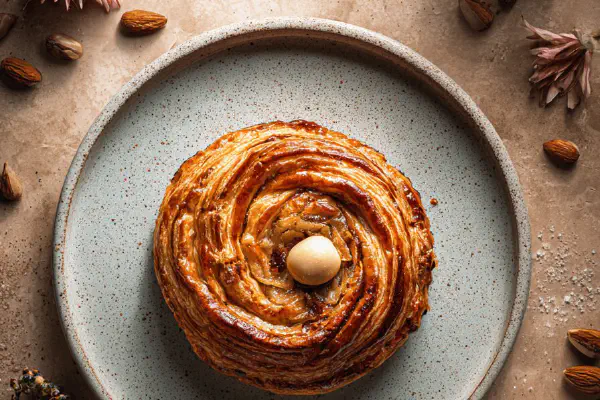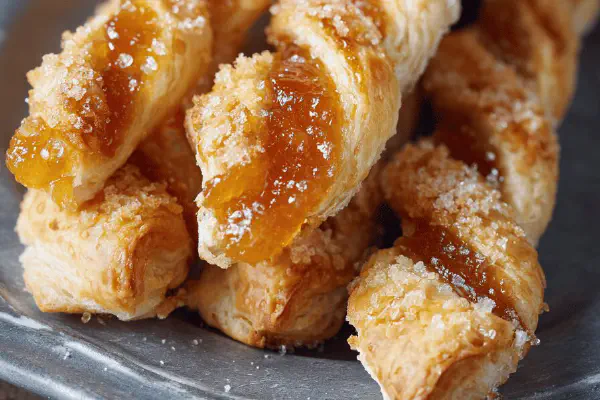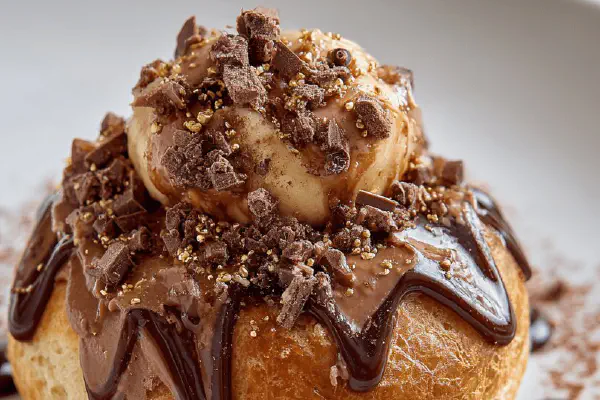Featured Recipe
Mango Pitahaya Tart

By Kate
"
A tart with a tender crust, rich pastry cream, topped with mango and pitahaya. Crust stays crisp under the cream. Vanilla bean infusion in cream makes the texture dense, not runny. Pitahaya adds subtle earthiness; mango brings juicy sweetness. Apricot glaze seals the fruit, adds slight shine and subtle tartness. Stepwise chilling ensures structure holds when serving. Adjusted flour and sugar balance keeps crust flaky but not crumbly. A touch of lemon zest in pastry cream cut into sweetness, keeps it fresh. Uses plant-based refined oil instead of butter for twist and allergy-friendly. Substituted tapioca starch for flour in cream for silkier finish. Instructions shuffled for workflow in busy kitchen.
"
Prep:
35 min
Cook:
20 min
Total:
55 min
Serves:
8 servings
dessert
tart
tropical fruits
pastry
Introduction
Crust that holds but doesn’t get tough. Pastry cream not runny, not gluey. Vanilla bean makes difference, seeds add aroma you can’t buy in extract. Tapioca starch swap cuts pasty mouthfeel of flour thickened creams; silkier, cleaner. Coconut oil instead of butter gives subtle tropical note, plus nut-free advantage. Pitahaya and mango — sweet meets earth, visually punchy. Layers of flavor and texture, but keep it simple. Timing? Chill your dough. Don’t rush that step. Overworked dough means shrinkage, dense crust. Watch pastry cream thickening carefully — thickens progressively, stops once it holds shape on spoon. Fruit cut thin, even. Glaze seals everything, keeps tart vibrant longer. Keep your work surface floured, tools sharp. Precision matters. It is work, but rewards multiply.
Ingredients
Crust
- 280 ml (1 1/5 cup) all-purpose unbleached flour
- 35 ml (2 tbsp) sugar
- Pinch salt
- 100 ml (7 tbsp) cold refined coconut oil solid
- 1 egg
- 15 ml (1 tbsp) ice water, more if needed
- 1 vanilla bean
- 350 ml (1 1/2 cup) whole milk
- 115 ml (1/2 cup) sugar
- 45 ml (3 tbsp) tapioca starch
- 1 egg
- Grated lemon zest from 1/2 lemon
- 1 ripe mango
- 1 pitahaya (dragon fruit)
- 60 ml (1/4 cup) apricot jam, warmed
Pastry Cream
Topping
About the ingredients
Flour amounts slightly reduced to prevent dry crust; flour type matters — unbleached keeps color and flavor pure. Sugar cut back a little in dough to avoid caramelizing raw taste. Replaced butter with refined coconut oil: more heat stable, dairy-free, subtle flavor twist; if unavailable, use cold solid vegetable shortening. Tapioca starch adds silkiness and transparent finish to pastry cream, better than flour for taste and texture; can swap for cornstarch but final look loses clarity. Vanilla bean key, but quality extract added at end if no bean at hand. Zest from lemon adds brightness, optional but refreshes flavor and offsets sweetness. Fruit quantity stays same, more mango than pitahaya for balance, or swap mango for papaya for varied tropical note. Apricot jam can be replaced with clear apple jelly; just warm before glazing. Keep all fats cold while handling dough to ensure flakiness. Water added incrementally to avoid sticky dough. Cold water slows gluten development for delicate crumb.
Method
Pastry Cream
- 1. Split vanilla bean lengthwise, scrape seeds out. Pour milk into saucepan. Add seeds and pod. Heat gently till steaming, not boiling.
- 2. In bowl, whisk sugar and tapioca starch. Add egg, mix smooth. No lumps. Pour in hot milk slowly, whisking constantly.
- 3. Return all to saucepan. Medium heat. Stir nonstop. Watch for thickening, around first bubbles. Thickness similar to yogurt. Keep stirring 1-2 min more to avoid raw starch taste.
- 4. Remove vanilla pod now. Stir in lemon zest. Cover surface tightly with plastic wrap, pressing to prevent skin. Let cool to room temp, then chill minimum 90 min. Thickens fully as it cools.
- 5. Pulse flour, sugar, salt in food processor. Add cold coconut oil cubes. Pulse until texture resembles peas, no big chunks.
- 6. Add egg and ice water gradually. Pulse till dough just forms clumps; if too dry, add tiny water drops carefully. Avoid overmixing, dough still crumbly but holding together.
- 7. Dump onto lightly floured board. Press and form 1 inch thick disc. Wrap in plastic wrap. Refrigerate 40 min minimum. Resting solidifies fats, less shrink in oven.
- 8. Roll dough out to circle slightly bigger than 23 cm (9 inches) tart pan. Use roller with dowels or guide sticks for even thickness. Transfer dough gently into pan. Press edges, trim excess.
- 9. Prick base well with fork. All over to prevent puffing. Rest tart shell in fridge 15 more minutes to chill again. This limits shrinking and bubbling.
- 10. Oven preheated to 205 °C / 400 °F. Bake tart shell on lower rack. Around 18-22 minutes. Watch for golden tan, especially edges. Should smell toasted but not burnt.
- 11. Remove from oven. Let cool 15 min on rack before unmolding. Handle carefully; crust fragile when hot.
- 12. Peel mango. Cut on either side of pit. Slice thinly lengthwise. Watch thickness about 3 mm for neat visual layering. Lay pieces flat on board.
- 13. Peel pitahaya carefully to keep thin layer of pink flesh under skin intact (adds color dimension). Slice just as thin. Reserve for decoration.
- 14. Spread chilled pastry cream evenly into tart shell. Level smooth with spatula, but avoid stirring to keep layers intact.
- 15. Arrange mango and pitahaya slices alternating in overlapping fan pattern. Builds height, looks natural, no wild gaps. If fruit is too much, save extra for salad or other dessert.
- 16. With small brush or spoon, glaze fruit gently with warm apricot jam. This locks moisture, adds light shine. Avoid gloppy or drippy layers; use just enough.
- 17. Chill assembled tart 1 hour minimum to let flavors marry and set.
- 18. Unmold just before serving. For clean edges, run thin sharp blade along pan sides beforehand.
- Serve slightly chilled, not cold for better flavor release.
Crust
Assembly
Technique Tips
Start with pastry cream to get chilling going early; vanilla pod infusion creates deep flavor which can’t be mimicked with extract alone. Whisk thoroughly when adding hot milk to egg mixture — sudden heat can scramble eggs if rushed. Stir constantly during cooking; scraping edges critical to prevent lumps and burning. Cover surface with plastic to stop skin formation; unavoidable otherwise. Chilled pastry cream firm enough but spreadable, use spatula not whisk. Dough requires minimal processing — over-pulsing equals tough crust. After dough rests, rolling technique crucial: flour surface lightly but don’t overuse flour to avoid dryness. Chilling dough slows fat melting, keeps dough solid when baked — results in layering and flakiness. Docking dough important to prevent bubbles, docking combined with chilling prevents casing gaps and air pockets. Baking on lower rack prevents over-browning top edges too fast, promotes even heat reaching bottom. Cool crust off-pan carefully; too hot is fragile. Fruit sliced evenly, thinly for attractive layering and bite-sized mouthfuls. Apply glaze with a soft brush quickly to prevent warming fruit and softening crust. Final resting time melds aromas and textures, also firms whole tart for neat slicing. Use thin blade when unmolding to avoid fracturing crust edges. Serve slightly chilled — too cold dulls flavor, room temp too softens cream and crust.
Chef's Notes
- 💡 When making the crust, keep coconut oil cold. If too warm, dough won't be flaky. Chilling the dough is mandatory. Rest it minimally for at least 40 minutes. It solidifies fats for better rolling.
- 💡 Watch the pastry cream closely. As it heats you’ll see the transformation. First tiny bubbles, then thickening. Stir continuously. Get the right consistency — like yogurt.
- 💡 If crust shrinks, maybe overworked dough. Keep everything cold. When rolling out, avoid extra flour. Just light dusting. Still, chill again before baking for best results.
- 💡 For fruit cutting, slice mango and pitahaya thin. Thin means elegant layers. Even cuts give great texture. Lay them carefully; overlap slightly to avoid gaps.
- 💡 Apricot jam glazing helps seal moisture but apply gently. Too much could make it soggy. Use a small brush. If no apricot jam, clear apple jelly works; warm it up a little.
Kitchen Wisdom
How long can I store the tart?
Store covered in fridge for 2-3 days. Crust may soften but stays decent. Can freeze before adding fruit for longer.
What if pastry cream is too runny?
If cream doesn’t thicken, heat it a bit more while stirring. Cook until it holds on a spoon. If not salvageable, start again.
Can I use another oil instead?
Yes, any refined vegetable shortening can work. But coconut oil adds a subtle hint. Butter is not dairy-free.
What if I can't find pitahaya?
Substitute with kiwi or even some vibrant berries. Colors matter for visual appeal. Change up flavors too.



